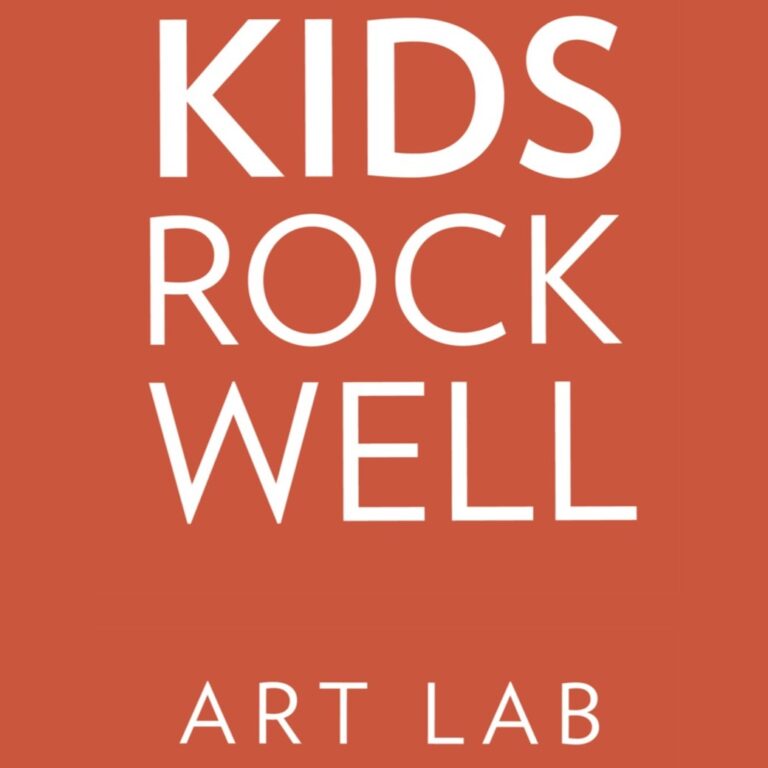Season: Winter
Hey….Where’s all the snow I keep hearing about?
Our weather is less snowy than in Buffalo, Rochester, or northern Pennsylvania. This is due to several key geographic and climatic factors, including the region’s distance from the Great Lakes, its terrain, and the local weather patterns that influence snowfall.
1. Distance from the Great Lakes
Buffalo and Rochester, located along the eastern shores of Lake Erie and Lake Ontario, are directly impacted by a weather phenomenon called lake-effect snow. This occurs when cold air moves over the relatively warmer waters of the lakes, causing moisture to evaporate, and when this moist air cools, it releases the moisture in the form of snow. This process produces heavy, localized snowfalls, particularly on the east sides of the lakes. Buffalo and Rochester are both in the direct path of these snow bands, which is why they often experience substantial snowfall in the winter.
In contrast, Finger Lakes Wine Country is located further inland, about 50 to 100 miles from the Great Lakes. While the region is still influenced by the lakes, it is far enough away that it does not experience the same intensity of lake-effect snow. The Finger Lakes still have a moderating effect on the climate, helping to keep temperatures milder, but they do not produce the heavy, persistent snowfalls that occur in cities like Buffalo and Rochester.
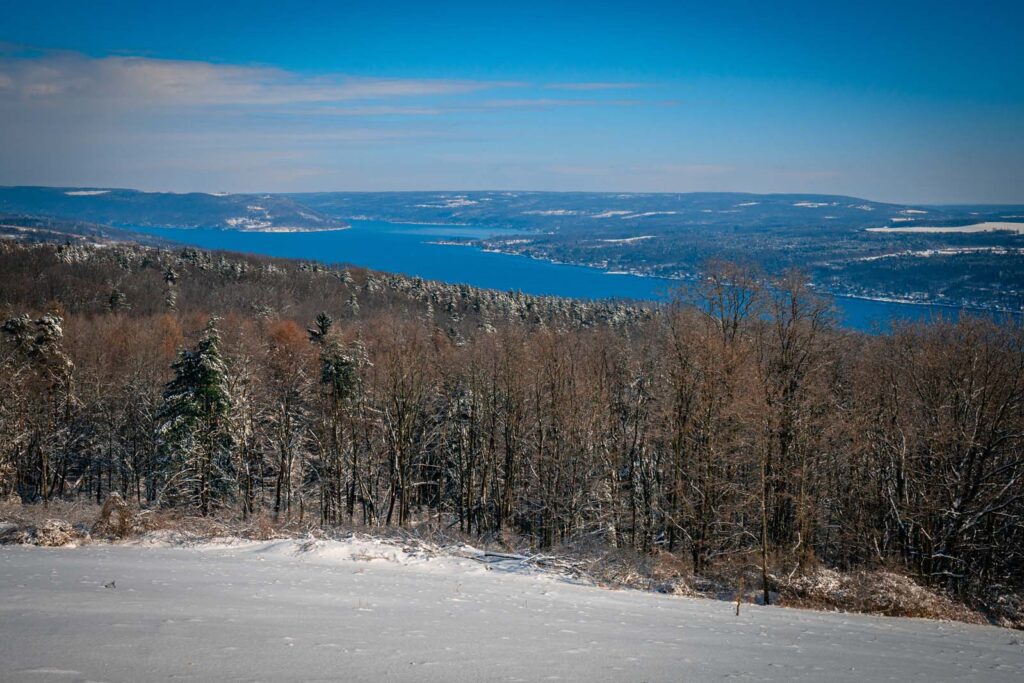
2. Topography of the finger lakes region
The terrain of Finger Lakes Wine Country plays a role in reducing snowfall. The region is characterized by rolling hills, valleys, and deep lakes that create a more sheltered environment compared to the open flat areas near the Great Lakes. These hills can block or weaken the lake-effect snow bands before they reach the Finger Lakes, preventing the area from experiencing the heavy snowfalls seen in nearby cities.
Additionally, the mountain ranges and higher elevations of northern Pennsylvania also contribute to more snow. In these regions, the wind patterns are more conducive to lifting moist air, which results in heavier snow. The Finger Lakes, on the other hand, are not as prone to these elevated snow-producing processes.
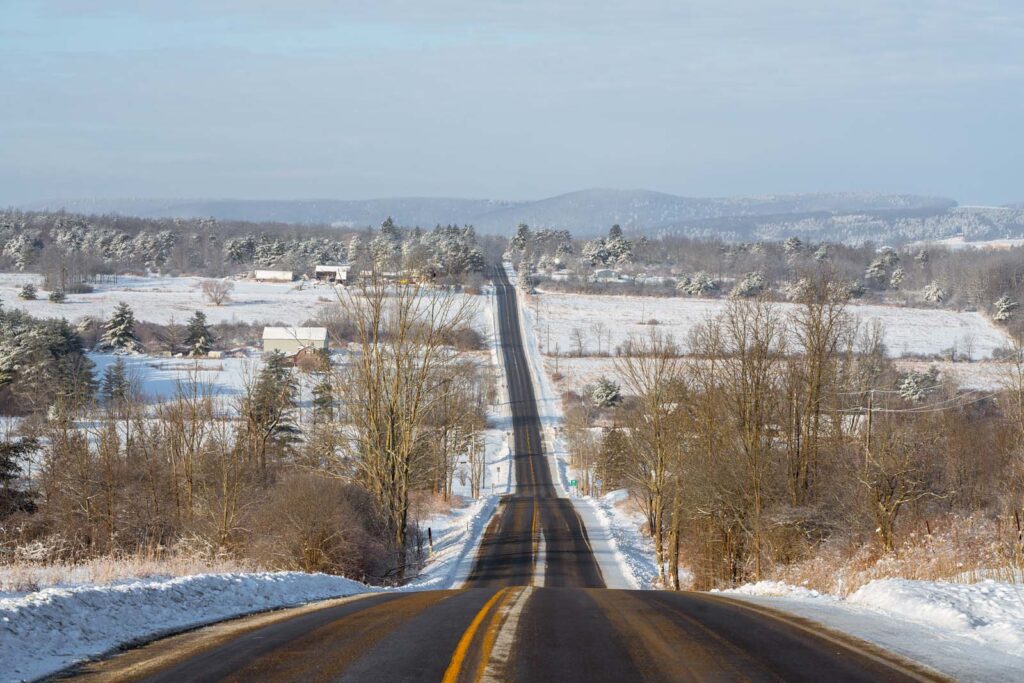
3. Wind Patterns and Lake Effect
The winds that bring lake-effect snow are generally westerly or northwesterly, blowing across the Great Lakes and onto the land. While Buffalo and Rochester are directly in the path of these winds, the Finger Lakes region is positioned more to the south and east, meaning it is shielded from the most intense lake-effect snow. The terrain of the Finger Lakes, with its valleys and the protection offered by the surrounding hills, means that many of the snow bands lose strength before reaching the area.
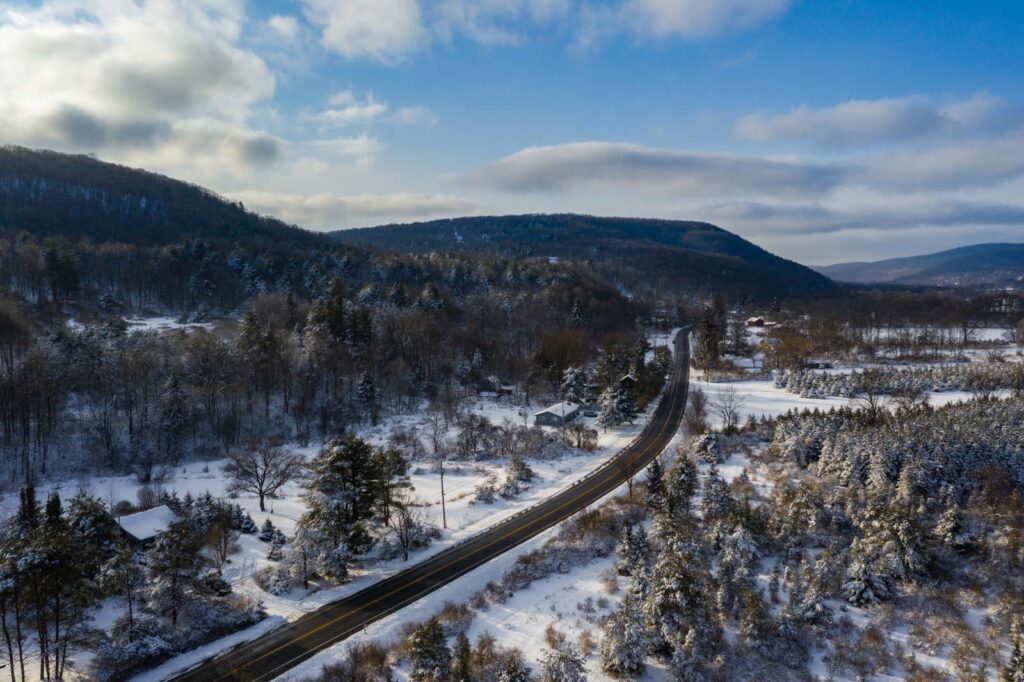
4. Influence of Northern Pennsylvania
Northern Pennsylvania, particularly areas like Erie and the Appalachian Mountains, is more likely to experience significant snowfall due to both lake-effect snow from Lake Erie and the upslope snow effect. The higher elevation and proximity to the Great Lakes in this region allow for more consistent snowfall throughout the winter. As the wind pushes moisture-laden air from the lakes, the air is forced upwards by the mountains, causing more precipitation in the form of snow.
The Finger Lakes region, by comparison, is lower in elevation and more shielded from these upslope effects, resulting in less frequent and less intense snowfall. The Finger Lakes’ climate is more moderate, and although snow can still fall, it is generally less persistent or heavy than in northern Pennsylvania or along the lakeshores of Buffalo and Rochester.
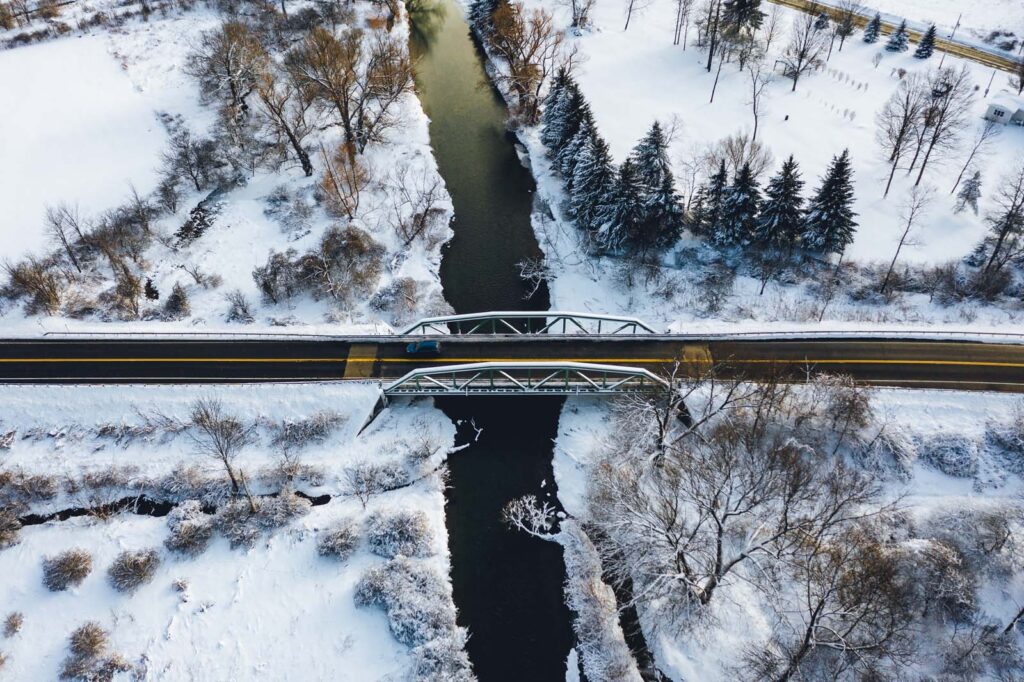
ALL THIS METEOROLOGY MEANS….
Finger Lakes Wine Country gets less snow than Buffalo, Rochester, or northern Pennsylvania because of its inland location, further from the direct influence of lake-effect snow caused by the Great Lakes. The region’s rolling hills and valleys shield it from the worst of the lake-effect snow, and the milder temperatures due to the distance from the lakes further reduce snowfall. Additionally, northern Pennsylvania’s higher elevations and proximity to the Great Lakes make it more prone to consistent snowfall, while the Finger Lakes region experiences a more moderate winter climate overall.
So, even though our lakes—Cayuga, Seneca, and Keuka—are “great,” they are not large enough to make a significant impact on snowfall amounts. So, if you hear about blizzards in upstate New York, they’re likely NOT referring to Finger Lakes Wine Country, so don’t let a few snow flurries keep you from visiting!
Next time you’re looking for a fun cocktail, try these delicious red wine cocktail recipes using Finger Lakes Wine Country’s famed red varieties like Pinot Noir, Cabernet Franc, and Merlot to name a few, paired with easy to find ingredients. Cheers!
Watch the Video!
After you’ve tried them for yourself, watch step by step as Megan from Finger Lakes Wine Country shows you ]how to make the Finger Lakes Red Wine Spritzer and the Upstate New York Sour.
While there is nothing more refreshing than a glass of rosé on a warm day, if you’re anything like us, you love rosé wine no matter the season! Ready to take your rosé game to the next level? We’ve got your back!
Combine some of our favorite Finger Lakes Wine Country rosés from wineries in our region with some of the best spirits from our region’s distillers in these simply delicious FLX Rosé cocktail recipes to try at home.
Watch the Video!
After you’ve tried them for yourself, you can see a couple of these recipes come to life as Megan from Finger Lakes Wine Country shows you step by step how to make these delicious drinks.
The Hunt family started crafting wine in 1981 and has been farming west of Keuka Lake in New York’s Finger Lakes region for seven generations. Hunt Country Vineyards is committed to responsible farming and caring for the land that gives us so much. They have reduced fossil fuel use by installing award-winning solar and geothermal systems. A portion of the vineyards are certified organic and several wines are made from organic grapes. Hunt Country Vineyard received the 2020 Sustainability Award from the New York Wine & Grape Foundation for its sustainability practices.
Growing up on the farm and with the winery inspired Suzanne Hunt’s passion for sustainability, climate solutions, and clean energy. She’s spearheaded a multitude of sustainability and climate resilience efforts. In 2021 Suzanne and her parents were recognized by Wine Business Monthly as some of the top leaders who shape the way the wine industry operates. In this interview, Suzanne shares ways others in the industry can work on being more sustainable.
Has Hunt Country Vineyards always been environmentally focused?
Suzanne Hunt: Yes, my parents bought the family farm from the previous generation in the 1970s because they wanted to live on the land. Environmental concerns have shifted somewhat over time. Decades ago, the key concerns for ecologically-minded farmers were things like DDT, erosion, and fertilizer leaching into water supplies. Nowadays the most pressing concerns include climate change, ‘forever chemicals’, invasive species, and loss of pollinators. Soil conservation has shifted to more complex considerations of soil health and soil as a tool in carbon sequestration and storage. Wildlife stewardship, erosion, and water quality concerns have been fairly consistent.
“The nuts-and-bolts of sustainable vineyard practices are waste reduction, energy and water conservation, and other essentials. But I would stress advocacy and customer education as well.”
Which processes were easier to implement?
SH: Well, every change requires effort. But some of the things we’ve done that are relatively straightforward and not difficult include: using only compost and manure as fertilizer instead of synthetic fertilizers, switching to efficient LED lighting, using eco-flooring and other eco-building materials, using lightweight/eco glass bottles, recycling, installing bird and bat boxes, and planting pollinator habitat.
What were some of the more challenging processes you experienced making the shift to a more environmentally focused vineyard?
SH: We have struggled with weed control in our certified organic vineyards. With a permanent crop like vines, we don’t have as many tools in our toolkit as our organic farmer friends who grow annual crops and can rotate crops and so on.
We were the first large complex geothermal system that the local companies had installed over a decade ago when we invested in a geothermal system to heat and cool all of our large buildings. The installers were learning as they went so we’ve had a lot more challenges with our geothermal system than folks will have now that there are more experienced installers, and better quality equipment that comes with diagnostic tools to target maintenance.
When we installed 348 solar panels on our building roofs in 2015, it took quite a lot of time and effort. Our local banks had never financed large commercial solar power systems so we arranged for the President of the NY Green Bank and some of his staff to spend an afternoon fielding their questions related to warranties, equipment depreciation, etc. Getting the permits was also much more of a struggle than it should have been.
We’ve had a harder time because we’ve been making these changes before they were common practice. It will be easier for other businesses that make the investments now.
What do you think are some of the most important practices of an environmentally focused winery?
SH: There are the nuts-and-bolts sustainable vineyard practices, waste reduction, energy and water conservation, and other essentials. But I would stress advocacy and customer education as well. The environmental challenges we face require direct action. Changing practices on our farms and in our businesses as well as society-wide approaches. Many of these environmental challenges are system-wide and societal challenges that require policy, regulatory, and systems changes.
As a highly visible industry, our voices as business leaders carry weight. We need to use them. And, we are also a rare part of farming where the public actually comes to spend time at our farms, which is an opportunity to help raise awareness and activate our customers.
Back to the nuts and bolts: farming involves challenging physical and economic conditions that are constantly changing – so it’s important to focus on constant improvement as our scientific knowledge expands and the tools available to us evolve. It is also critical to focus on practices that will enhance the resilience of your operation as well as provide environmental benefits. A good example of a practice that achieves multiple goals, including enhancing resilience to extreme dry and extreme wet conditions (which will worsen as climate change intensifies), is enhancing soil organic matter.
The new New York State Sustainable Winegrowing certification program is a good place to start. Growers and wineries can go through hundreds of aspects of their business and identify areas for improvements related to environmental impacts but also safety and other social and economic sustainability metrics.
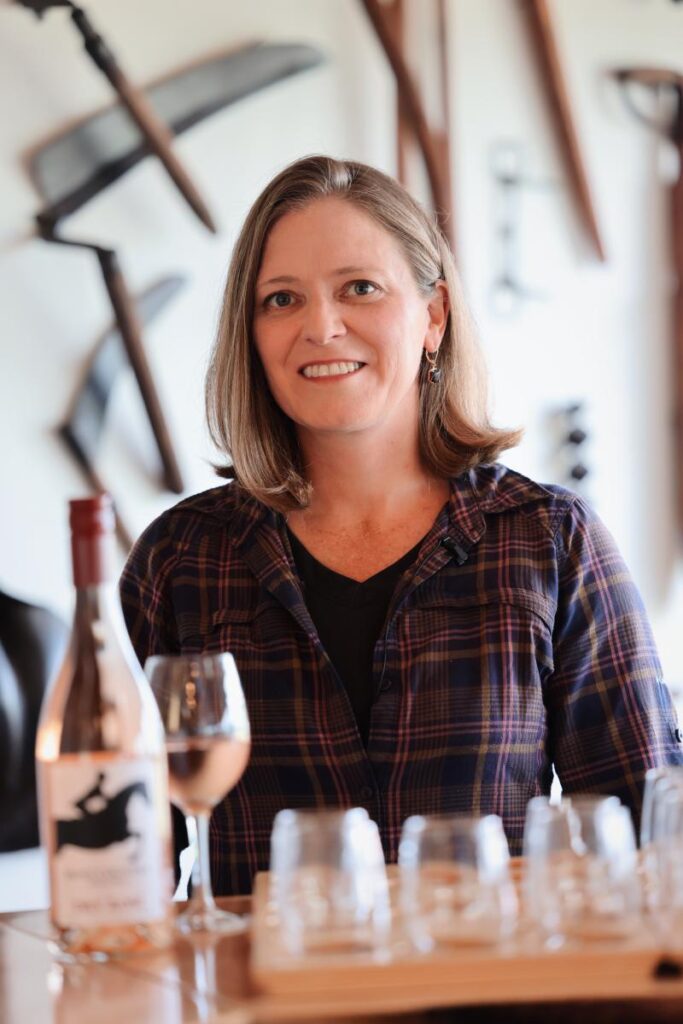
What other local (or national) wineries are doing the work?
SH: We are the first New York winery to join the International Wineries for Climate Action (IWCA) organization that was co-founded by two large international wineries: Torres Family Winery (from Spain) and Jackson Family Winery (headquartered in California). But the IWCA has members of all sizes including Cakebread Cellars, Opus One, and other well-known brands. To become a member you have to go through a rigorous greenhouse gas accounting process and third-party audit.
About a dozen New York winery owners serve on the New York Wine and Grape Foundation’s Sustainability Advisory Committee which I chaired until recently. We have spent the past several years developing and testing out a sustainability certification program designed for New York grape and wine producers. Currently, we, and several dozen other Finger Lakes producers, are in the process of getting certified. Soon New York wine drinkers will start seeing the New York Sustainable Winegrowing ‘Trustmark’ on our websites, social media posts, and eventually bottle labels.
What do people need to look out for to confirm if a winery has sustainable practices?
SH: Consumers can look for trust marks but until now we didn’t have a comprehensive sustainability certification that was relevant to New York wine growers. So the most important thing consumers can do is ask questions and get to know the wineries that they frequent. Read articles like this and educate yourself on who the leaders are and support them!
“Every generation that came before us had to innovate to succeed in farming and business. We are no different, but the pace of change is accelerating, making innovation even more critical to our ability to succeed.”
What inspired your passion for climate solutions and clean energy?
SH: This place. Growing up on the farm and with the winery. It was really hard-going for my parents when I was a kid. They, and their contemporaries, were building a New York wine industry almost from the ground up after the grape market crashed. They made sure my siblings and I could follow our passions and mine was always the environment.
I was able to get degrees in Environmental Science, Natural Resources Management, and International Affairs and work in the environmental field all over the world before returning home. I still work in sustainable infrastructure, agriculture, and transportation-related policy. Although you could argue that having two full-time jobs is not sustainable!
Why is innovation so important?
SH: Farming has always been hard. Nowadays the impacts of climate change, labor shortages, economic crises, and other disruptions are making it even harder. Every generation that came before us had to innovate to succeed in farming and business. We are no different, but the pace of change is accelerating, making innovation even more critical to our ability to succeed.
What are some ways Hunt Country Vineyards has had to innovate?
SH: So many ways! The winery was an innovation in response to the grape market crash. In the 1970’s after the grape market crashed my parents learned how to make wine out of the hundreds of tons of grapes they couldn’t sell. Not all of the varieties that they were growing were desirable for winemaking, but the vineyards were the collateral on the loans they took out to plant the vines so they couldn’t rip them out. So my dad worked with Cornell and pioneered cold climate field grafting and grafted new varieties onto some of the existing vineyards.
In the 1980’s our ice wine bottles were too small for our labeling machine so my dad attached an electric motor to a manual labeler from 1910. There are countless examples like that. My mom helped start up several Finger Lakes wine promotion organizations and programs.
Most recently, the release of our Uncharted Terroir (UT) line of wines is an innovation in response to the unpredictable impacts of climate change. Our UT wines are made from hybrid grape varieties that have typically been looked down on in the wine world. But when you give these grapes the same love and attention as their vinifera cousins, you can make outstanding wines.
Hybrid grapes are far more resilient and rugged than vinifera grapes, so they can withstand and bounce back from the increasingly frequent extreme weather events we are facing. For example, the surprise frost in May 2023 that hammered vineyards in New York devastated our Cabernet Franc, Chardonnay, and Riesling. But our Vidal Blanc and Vignoles look like they’ll still give us a significant crop.
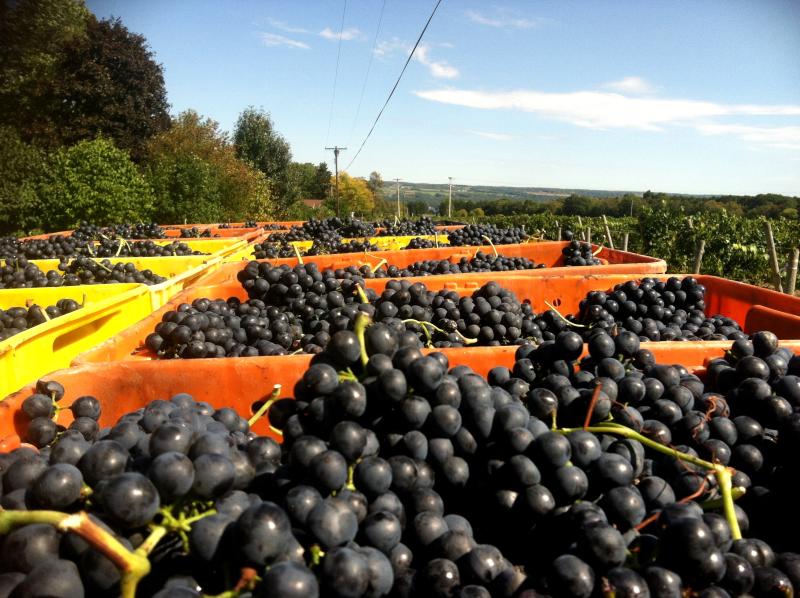
What advice can you offer smaller wineries that don’t have huge budgets to invest in large sustainability-focused infrastructures/processes, but want to be more environmentally conscious?
SH: Work with your local soil and water department. They can often help with technical assistance and potentially partner on grants to help test out or implement new practices. Right now we are working with our local soil and water department on a project to study the effects of adding compost and biochar to our vineyards and hay fields funded in part by a climate-smart agriculture grant. We are also working with them, along with some of our neighbors, to test out an under-the-row mower.
Develop a strong relationship with a local bank so that you can use loans to pay for some of the investments with shorter payback periods. Develop partnerships. For example, we partnered with Tesla to install five electric vehicle charging stations in our parking lot.
In what ways are you looking to expand in the future?
SH: We’re always looking for new ways – big and small – to improve. My dad is always tweaking, and even inventing new machines and strategies to try to improve practices in the vineyards. We’ve worked closely with researchers at Cornell over the decades on improved management strategies and will continue that collaboration.
From a climate impact perspective, packaging is one of the biggest sources of greenhouse gas emissions from the wine industry. Glass manufacturing requires an enormous amount of heat, and in the U.S. right now that heat is supplied primarily by fossil fuels. I’m in the very early stages of working with large wineries to try to create enough demand to get our glass suppliers to work with the government and renewable fuel suppliers to slash their emissions. We’re also always working on phasing in electric vehicles.
In collaboration with scientists at the US Department of Agriculture, we are going to plant a 5-acre field next to the forest on our farm with wildflowers to support native pollinator populations – many of which are ground-dwelling and benefit from proximity to forest habitat. We’ll manage the field to keep in wildflowers into the future.
From a broader ‘what people need right now’ perspective, we are focusing on getting people here for hands-on (phones off) workshops and retreats focused on skills development, enhancing well-being, community building, and problem-solving.
Our advocacy is focused on the implementation of the New York climate law and on the conservation title of the federal Farm Bill which is only renewed once every five years.
In addition to being a co-owner of her family’s seventh-generation farm and winery, Suzanne Hunt is the Vice President for Public Policy for Generate Upcycle, PBC which finances, builds, owns, and operates sustainable infrastructure projects in North America and Europe.
It takes courage and a sense of adventure to be a trailblazer and Glenora Wine Cellars was the first winery on Seneca Lake. Gene Pierce, along with Eastman Beers, Edward Dalrymple, and Howard Kimball jumped at the opportunity to open the winery after the Farm Winery Act of 1976 was passed.
In 1987, the winery expanded its production facility, and retail sales area and added a restaurant, The Wine Garden Café. This was the first winery restaurant on the western shores of Seneca Lake. They introduced a unique winery resort to the region with a 30-room Inn and Veraisons Restaurant in 2000. Offering guests the finest accommodations and farm-to-table cuisine after exploring our Wine Trails.
Widely known for its warm hospitality and outstanding lakeside setting Glenora Wine Cellars has been producing award-winning Finger Lakes wines and offering year-round hospitality since 1977. Today, the owners are Gene Pierce and Scott Welliver and we got to speak with Gene about being a trailblazer and what’s next after nearly 50 years!
How have you seen the culture of the wine industry changing since Glenora’s inception in the 1970s?
Gene Pierce: Most wineries in the 1980s and early 1990s were formed by people who were already in the wine and grape industry, knew one another, and did things together; it was a more cohesive group. Today, people are coming in from outside; we don’t know if they are aware of the region’s history and culture.
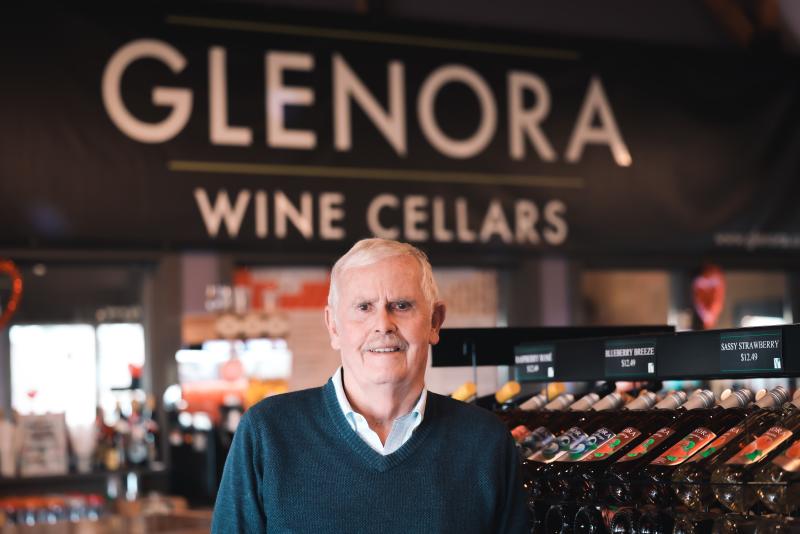
As the first winery on Seneca Lake, what changes have you seen?
GP: Almost everything! We’ve witnessed the viewpoint grow from one winery in 1977 to over 60 now. From very few accommodations to numerous today, with even major brands, such as the Hilton, being here. Airbnbs, etc. We’ve seen the industry’s influence on tourism, restaurants, entertainment, and more.
In your opinion, what makes the offering at Glenora Wine Cellar unique to other wineries in the region?
GP: In a lot of ways, perhaps Glenora isn’t that unique if you look at what other wineries are doing, (food trucks, music, etc) Our restaurant started in 1988 and we expanded our lodging facilities soon after. One of the unique things is our VIEW – when you stand or sit on the deck at Glenora, you can literally see from Wagner to almost Watkins Glens. We did not develop this, but this is a gift and different from the other wineries on Seneca Lake.
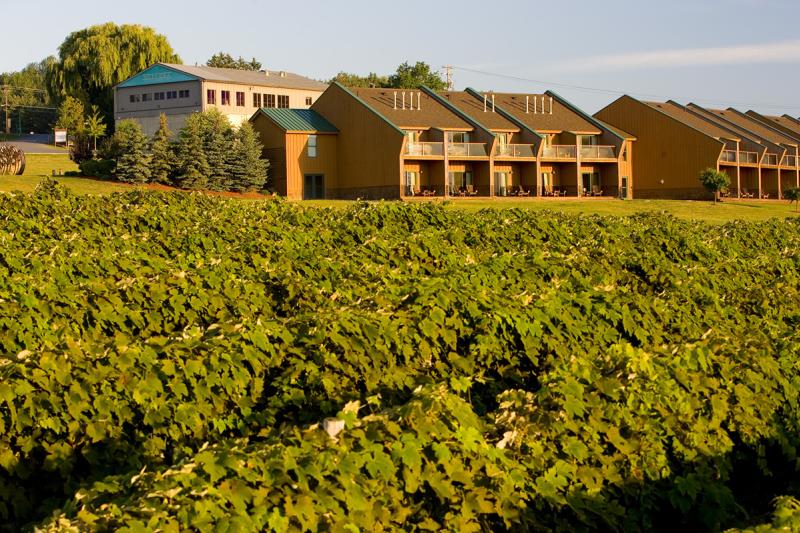
Another feature that distinguishes Glenora is our lodgings; we take winemaking and tastings seriously, but we also provide an inn and a restaurant. There is no other winery that provides these services in one location.
In 1987 the Wine Garden Café was the first winery restaurant located on the western shores of Seneca Lake. Since 2000 the 30-room Inn and Veraisons Restaurant have been in operation. What’s next for both of those locations?
GP: At this point in the industry’s development, from a winemaking and hospitality standpoint, we really want to make sure our next moves will fit within Glenora and the industry. The Garden Cafe was a shot in the dark. We spent millions of dollars on the restaurant and inn, and people questioned both of those decisions, but we felt confident it would succeed. Maybe a Ferris wheel should be NEXT!
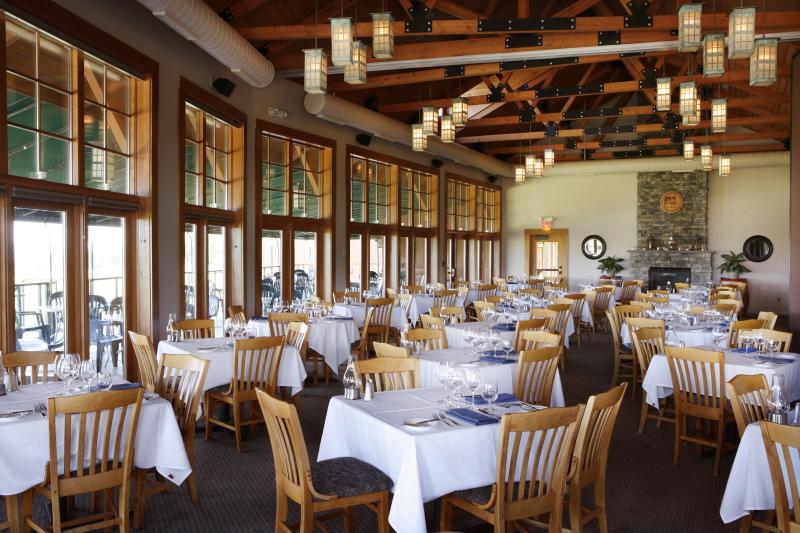
What does the word trailblazer mean to you?
GP: Daniel Boone in the Finger Lakes Wine industry and Seneca Lake Wine Trail. Someone who isn’t afraid to take chances and risks; who does things in a way that others can understand and enjoy, and who others may follow in the future.
Your award-winning wines are beloved by its fan base, new and old. Aside from being known for your quality wine, what else do you want people to know about Glenora Wine Cellars?
GP: Well, I appreciate that they enjoy our wines and that they are of high quality, but that does not make us unique; what I hope they see is our hospitality. Our welcoming people to the area. A friendly place that can accommodate several people wanting to visit for the wines, environment, and hospitality.
The climate of Finger Lakes Wine Country is ideal for growing grapes due to a combination of factors related to temperature, humidity, soil, and the unique geography of the region. Here’s why the Finger Lakes region, including areas like Seneca Lake, provides an excellent environment for viticulture:
1. Moderating Effect of the Lakes

The Finger Lakes are a series of long, deep, glacial lakes, and their large bodies of water play a crucial role in regulating the climate in the surrounding areas. During the growing season, the lakes act as a thermal buffer, absorbing heat during the warmer months and releasing it slowly in the cooler months. This moderates temperature extremes, protecting vines from late spring frosts and early autumn freezes. The relatively longer growing season this creates allows grapes to ripen fully, while also helping to preserve their acidity, which is crucial for producing high-quality wine.
Summer: The lakes help maintain a moderate daytime temperature. While the surrounding regions may experience hot spells, the lakes’ waters help keep the air cool, preventing the grapes from overheating.
Fall: As temperatures begin to cool in the autumn, the lakes continue to release heat, providing a more gradual transition to cooler weather. This extended growing season is essential for grape ripening, especially for varieties like Riesling, which thrive with a long, cool growing season.
2. Cool Climate Viticulture
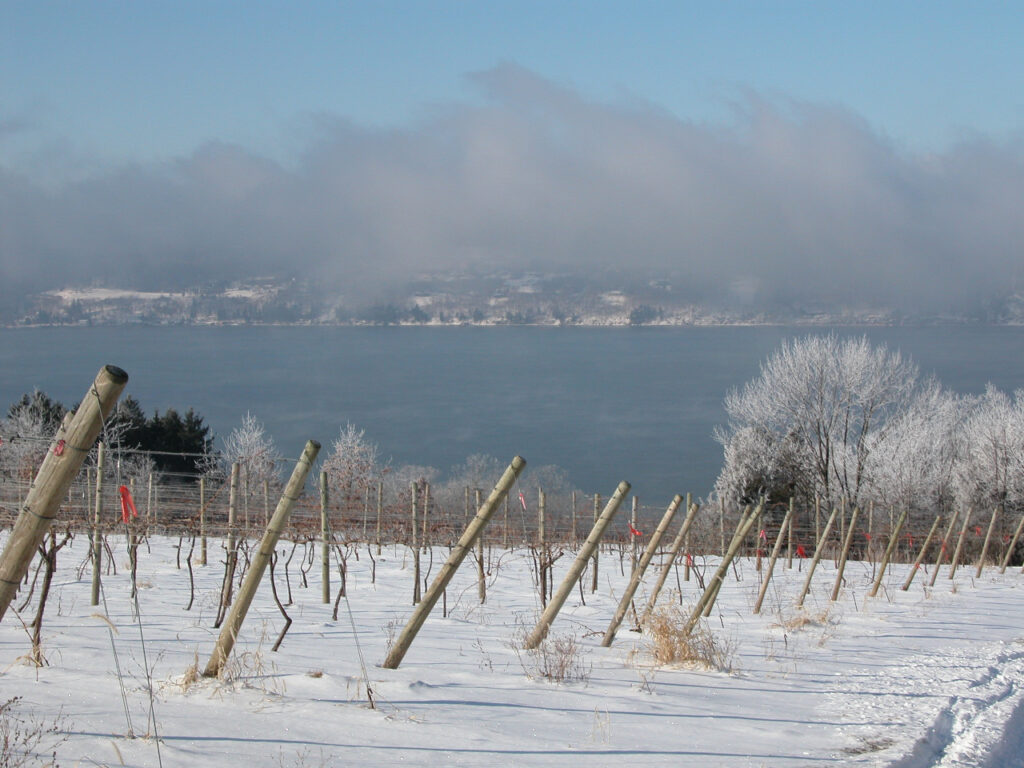
The Finger Lakes region is considered a cool-climate wine region, which is perfect for certain grape varieties that prefer cooler growing conditions, such as Riesling, Chardonnay, and Pinot Noir. The cooler climate helps grapes maintain their acidity, which contributes to the crispness, balance, and freshness of Finger Lakes wines.
Cooler temperatures also help prevent over-ripening of the grapes, which can lead to a loss of delicate flavors and aromatics. This is particularly important for white wine grapes, which require cool weather to maintain their signature bright, fresh profiles.
3. Soil Composition
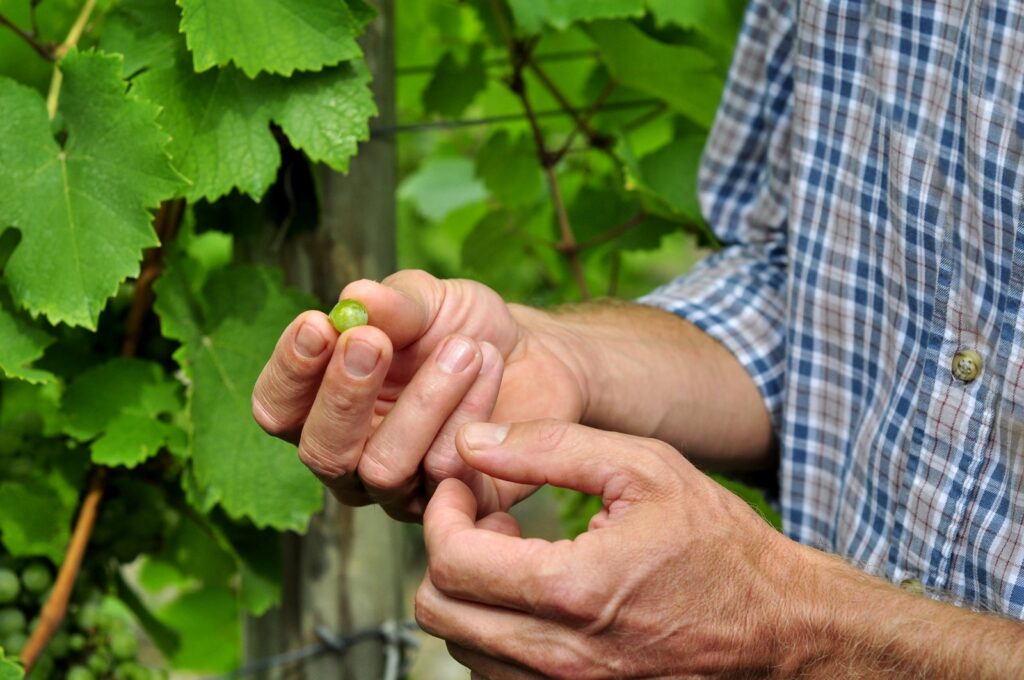
The Finger Lakes region benefits from well-drained, nutrient-rich soils, especially around the lakes. The soil is often a mixture of loam, clay, and gravel, which provides excellent drainage while holding just enough moisture for grapevines. These well-draining soils help prevent root diseases and ensure that the vines are not waterlogged, which could otherwise negatively affect grape development.
In addition, the glacial deposits in the region have left a rich mixture of minerals, which contributes to the terroir of the wines. The mineral content in the soil helps give Finger Lakes wines their unique, often mineral-driven characteristics.
4. Topography
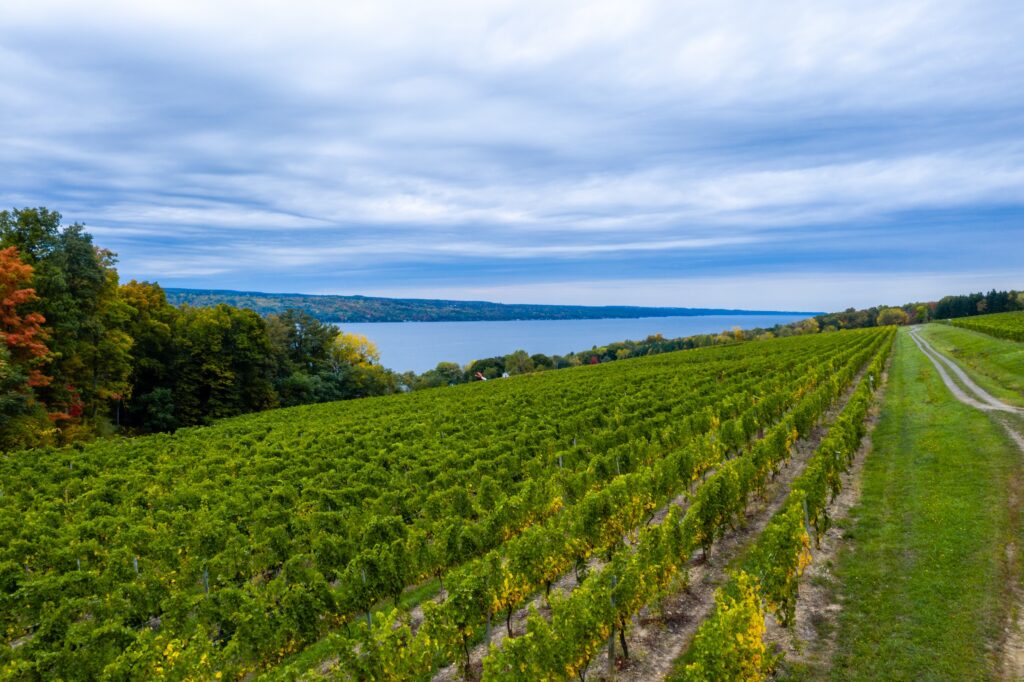
The region’s hilly, sloping terrain is another factor that makes it suitable for grape growing. The hillsides allow for optimal sun exposure, ensuring that grapevines receive plenty of light during the growing season. Vineyards planted on south- or west-facing slopes get more sunlight, which aids in grape ripening and helps concentrate flavors in the fruit.
Additionally, the slopes help with air circulation, reducing the risk of frost in the spring and fall. Cold air tends to settle in valleys, so by planting vineyards on elevated sites, wineries can reduce the chances of frost damage, especially in early spring when frost is most damaging to delicate grape buds.
5. Humidity and Rainfall
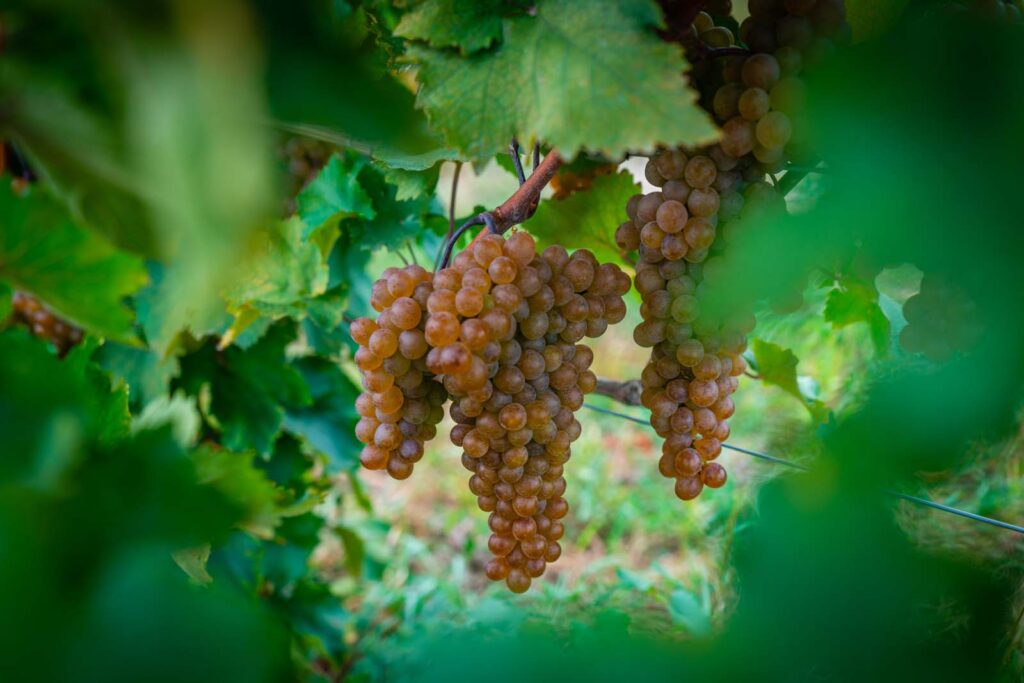
The Finger Lakes region enjoys moderate precipitation, which helps maintain healthy soil moisture for grapevines. The region typically experiences around 30-40 inches of rain per year, which is enough to keep the vines hydrated without causing excessive waterlogging.
In terms of humidity, the lakes themselves contribute to a relatively humid environment. While too much humidity can promote fungal diseases, the region’s cooler temperatures and good airflow (especially around the lakes) help mitigate this risk, ensuring that vines remain healthy.
6. Protection from Harsh Winters
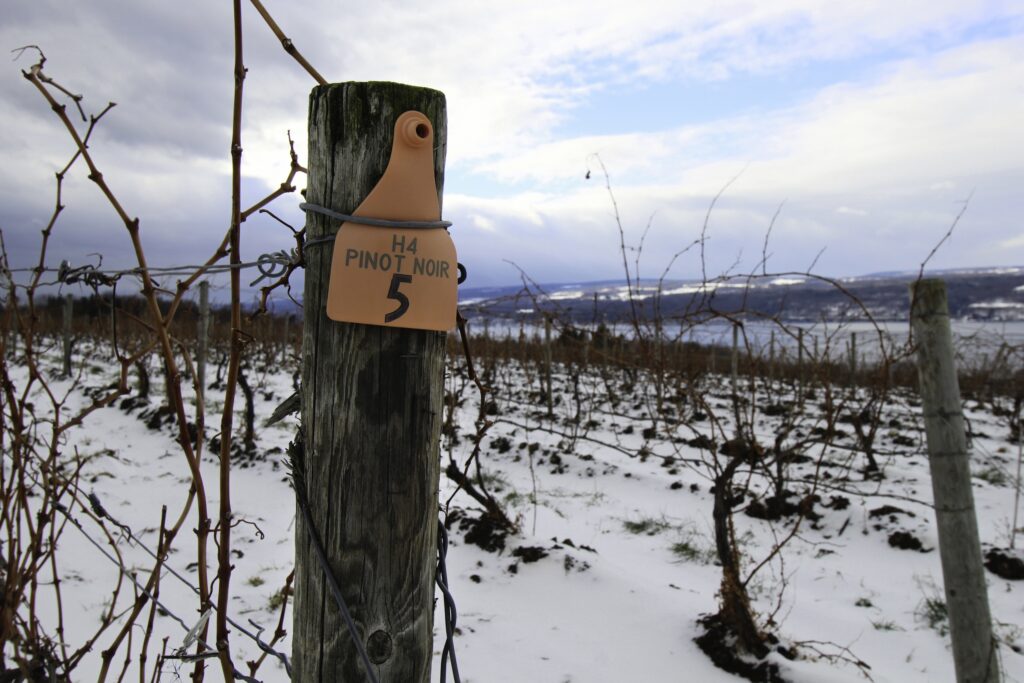
While the Finger Lakes region does experience cold winters, the moderating influence of the lakes helps protect the vines from the extreme winter temperatures experienced in more inland, northern regions. In addition, many vineyards practice winter protection techniques such as burying the vines or using wind machines, helping to further shield the vines from frost damage.
7. Regional Climate Variations
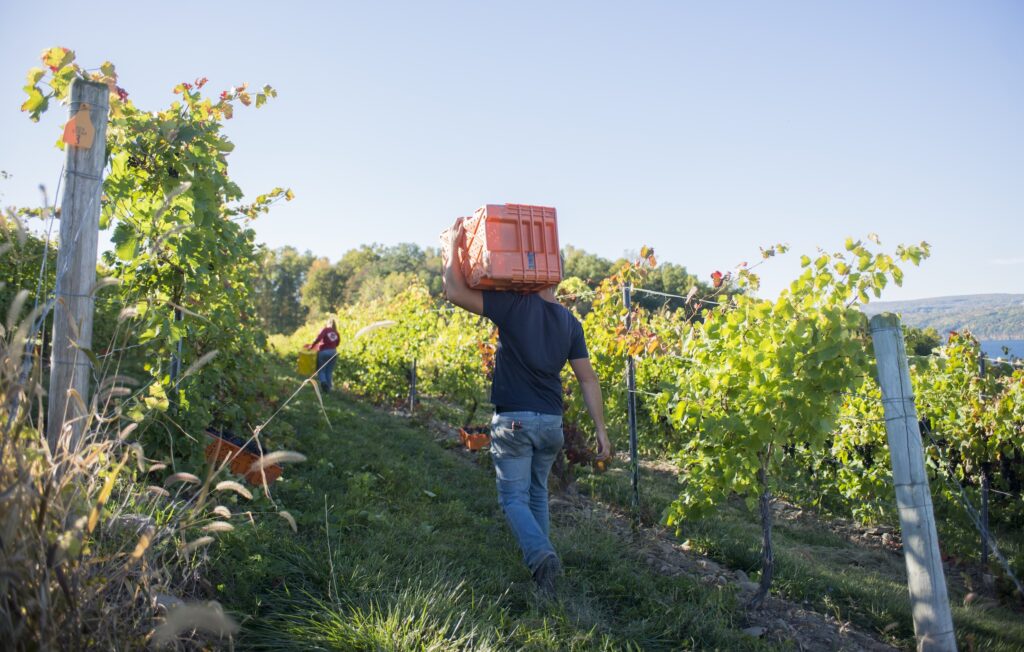
Different Finger Lakes, like Seneca Lake, Keuka Lake, and Cayuga Lake, each have their own microclimates, influenced by their size, depth, and orientation. These microclimates can create subtle variations in temperature and humidity, which allows winemakers to experiment with different grape varieties and styles of wine.
For example, Seneca Lake has the deepest of the Finger Lakes, which means it has a greater capacity to moderate temperatures, creating an even more favorable growing environment for longer-maturing grape varieties like Cabernet Franc or Gewürztraminer.
Overall, the cool, moderate climate, combined with the protective influence of the lakes, well-draining soils, and favorable topography, makes Finger Lakes Wine Country one of the best places in the U.S. for growing high-quality grapes, particularly cool-climate varieties. These conditions allow the region to produce wines with exceptional balance, crisp acidity, and distinct terroir, making it a renowned wine-growing region.
